
In Tomball Texas there is a small burger cafe called Mel’s country cafe. Here is a quote from their website:
“ The Mega Mel Burger: One & a half pounds of ground beef, a FULL pound of bacon, 1/4 pound of cheese & all the trimmings.
The Challenge: To get your name on the wall you must eat everything on your plate in under 2 hours without help, and be able to walk and talk without getting sick. (Note: You may be stopped if we feel you are going to get sick.) “
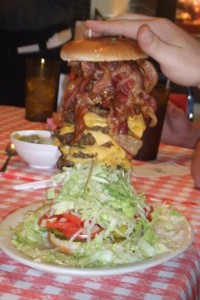
Mega Mel Burger, Tomball Texas
It is disgustingly awesome. This burger is an estimated 4,556 calories. And well over 100 grams of fat.
My buddy Alex sat down and ate the entire thing in one sitting. His name is on the wall of fame.
Guess What, He Did Not Die.
Last time I talked about how fat is good for you. Specifically regarding Omega 3 fatty acids. I even mentioned a great study showing an increase in protein synthesis from Omega 3 supplementation.
So should you be taking on this massive burger every day? Is a full pound of bacon a good idea?
Hold on bro!
Fats Bad Rep
Fat has a bad reputation because consumers don’t want to be overweight, and they do not want to die from heart attacks or strokes. I understand their concern. Let’s see what other positive roles fat is used for in the body. Then we will see why mistreated fat can be harmful to an athlete or just a regular guy.
Cholesterol
Your body needs fats in your bloodstream. The most common types of fats (lipids) in your body are cholesterol and triglycerides. Your body needs cholesterol to function properly. Your body naturally makes cholesterol in your liver. Cells in your body need fat to protect their cell membrane. Your skin uses sun light and cholesterol to make vitamin D. Cholesterol has an important role in creation of hormones. Hormone creation is vital to elite athletes (especially creation of the hormone insulin). Foods high in cholesterol are egg yolks, butter, liver, shrimp, cheese, processed meats, oil pack fish to name a few.
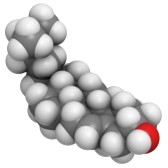
Cholesterol
Triglycerides
Triglycerides are used in your body for energy. Triglycerides are consumed in your diet and created in your liver. Foods high in triglycerides are fatty foods, refined carbohydrates, simple sugars and alcohol.
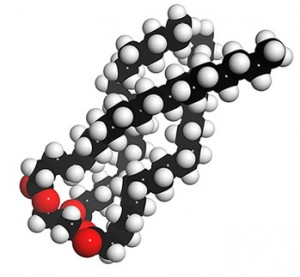
Triglyceride
Fat Movement
Lipids in your liver do not move on their own. For your lipids to be able to move from your liver through your bloodstream to the needed area, requires certain proteins to wrap around the lipid. This new molecule is called a lipoprotein. This lipoprotein can move where the cells need the cholesterol or triglycerides.
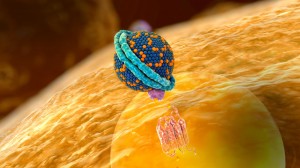
Lipoprotein
Lipoproteins are full of cholesterol and triglycerides. Your liver makes VLDLs (Very low density lipoproteins). VLDL travels through your bloodstream and transports triglycerides, phospholipids, cholesterol, and cholesteryl esters .
How To Become a Fatty LDL
If your body produces more VLDL than your body needs, your body will store the extra triglycerides as body fat. After a VLDL loses its triglycerides, it becomes a LDL (low density lipoprotein). LDL travel through your bloodstream delivering cholesterol to the cells that need it.
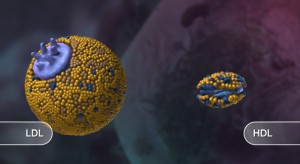
ldl and hdl
If your body makes too much LDL than LDL can build up in your blood. It can deposit in the walls of your blood vessels. Causing a buildup of fatty material called plaque. Overtime, this build up can restrict blood flow and increase the risk of heart attack or stroke. This is why LDL is considered the bad cholesterol. A common place for this build up is the coronary arties. Which increases heart attack risk. Or it can build up in arteries in your neck, decreasing blood flow to the brain and increasing the risk of a stroke.
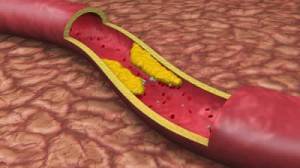
Plaque build up
The Good Fat, HDL
Your Liver also makes high density protein called HDL for short. HDL has more protein and far less cholesterol and triglycerides. HDL can help remove excess cholesterol from your cells. HDL can also help remove plaque build-up in your arteries. HDL takes the excess LDL cholesterol to the liver where it is reprocessed. Simple put HDL is acting in ways to help clean up your bloodstream of excess bad cholesterol.
Fat Testing
The very best way to test your blood is by a fasting lipoprotein profile test. Your total cholesterol goal should be less than < 200 mg/dL, HDL of 60 mg/dL or higher (typically athletes have much higher HDL), LDL < 97 mg/dL and fasting triglycerides < 150 mg/dL. These numbers vary by your age and goals. Athletes are typically active as possible and their lipid profile is an afterthought. But it is still good to know. None of my readers will walk away with no knowledge of fat in the bloodstream.
Forever And Today’s Goals
Raise your HDL levels. This knowledge alone my save your life. Or your father’s life. I had a grandfather (RIP) with heart problems and a mother with high blood pressure. I want you to live a LONG healthy life. And throw the baseball very fast. But throwing hard, and living long are both important.
In order to raise your HDL levels there is a few simple and crucial things you must do.
- If you smoke, stop.
- Exercise everyday (Duh!)
- Increase your Omega 3 intake and decrease your Trans Fat consumption
Know exactly what you are putting into your body, and why.
Unsaturated Fat and Saturated Fat
The term unsaturated fat is referring to the fatty acids with at least one double bond within the fatty acid chain. Saturated fat is fat that consists of triglycerides containing saturated fatty acids with no double bonds and is fully “saturated” with hydrogen atoms (the max amount of hydrogen atoms).
Unsaturated Fats
Unsaturated fats are typically separated into two categories: monounsaturated fats and polyunsaturated fats. Polyunsaturated fats are can be sub categorized into 2 types, Omega-6 polyunsaturated fats and Omega 3 polyunsaturated fats.
It is believed that taking Omega-3 fatty acids can reduce post workout inflammation and speed up muscle repair. Studies have also shown that Omega 3 fatty acids raise high density lipoprotein 2 (HDL) levels in healthy volunteers.
Low levels of omega-3 fatty acids, along with high level of omega-6 fatty acid intake is associated with heart disease, autoimmune diseases, diabetes and other degenerative diseases. The proper ratio is 3:1 omega 6 to omega 3, or less.
The best way to balance your omega 3 to omega 6 ratio is to supplement flaxseed oil. Buy some here. I try and take 2 tablespoons everyday.
Trans Fatty Killer
Trans fatty acids is made by adding hydrogen to vegetable oil through a process called hydrogenation. This process helps food stay fresh longer and have a longer shelf life. The results: It raises your LDL and lowers your HDL. Increasing your risk for heart disease. The leading killer of men and women. These negative effects take place over time. Heart disease is known as the “silent killer.” One day you don’t wake up…yea it’s scary. Avoid Trans fat and your risk for heart disease will decrease. The best way to do this is to read the labels of products you are buying or consuming. Here is a list of food likely to be high in partially hydrogenated oils:
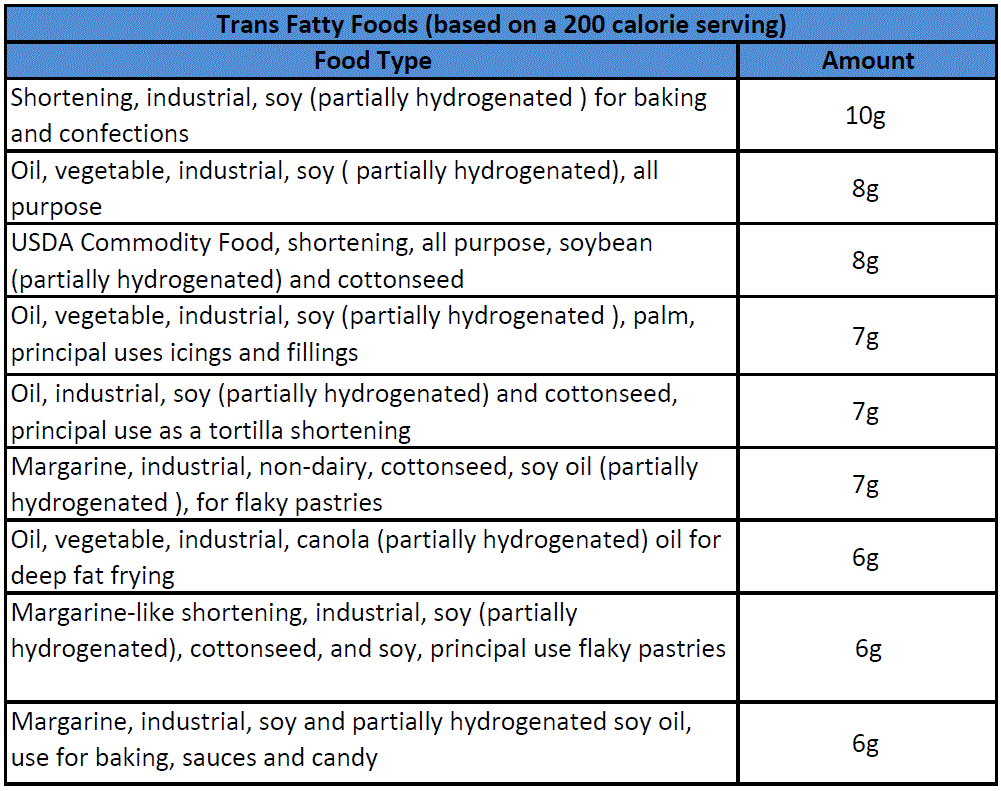
It is important to note that “fully” hydrogenated oil does not contain Trans fat. Partially hydrogenated oil does. As you can see, it is mentioned a lot in the above chart.
The Debate
There is a debate raging about whether or not saturated fat is really linked to heart disease. There is countless list on the internet that says avoid saturated fats. While other gurus claim you should eat certain saturated fats. I already touched on the importance of cholesterol and triglycerides in your diet for energy and vitamin transportation etc. But if you have too much, you are going to run into many problems. You will end up with long term problems that are hard to fix without surgery. So instead of me going into a rant about how you should not eat French fries but you should eat butter and eggs, I am going to allow you to dig deeper into this subject yourself. You are welcome to debate me or send me articles. But really I want to keep your long term heart health simple.
The very best way to raise your HDL is to increase moderate exercise every day and increase your omega 3 intake. There is so many benefits of omega 3 fatty acids that you should be required by law to take them every day. But I can’t change the laws….
Athlete Fat
Athletes, for optimal performance in training , muscle development and your general health, you need roughly 33 percent of your diet to contain fat. Limit 30 percent of your total fat (approx 11 percent total diet) can be saturated fat. There is an assumption that saturated fat is bad for you, this is not full truth. Saturated fat can be beneficial like any other fat. If your saturated fat is in excess, it will increase your LDL levels which can lead to hypertension, heart attack stroke etc.
The rest of your diet will consist of lots of protein and carbs. We go into the exact number and steps regarding daily fat consumption in the throw cheese nutrient system “Re-Build Stage.” The longest and most important stage of muscle growth.
What You Need To Do
Right now, begin the process of caring about your fat intake. Buy some flaxseed oil here. Figure out your favorite fish to eat that is high in unsaturated fats (I like salmon). Limit/eliminate your trans-fat intake.
I look forward to you being happy and healthy many days to come. 6 packs are cool, but I really want you to throw gas. So let’s get to work.
With love,
Zach
PS: buy omega 3 flaxseed oil now before you forget. Your life pretty much depends on it. Click here.
PSS: We bash cheese here are PitcherThrowCheese.com. You don’t need that kind of saturated fat. Its slow (opposite of what we need in the Throw Cheese Nutrient System)…its low in protein.
PSSS: Remember to always appropriately define the term “bad” or “good.” It requires each us to be more specific and to add context to every situation. Your body is a large chain of moving parts and system that effect each other.
References:
http://heartdisease.about.com/od/cholesteroltriglycerides/fl/The-Dark-Side-of-ldquoGoodrdquo-Cholesterol.htm
http://www.webmd.com/cholesterol-management/hdl-cholesterol-the-good-cholesterol
http://www.medscape.org/viewarticle/479499_5
Franceschini G1, Calabresi L, Maderna P, Galli C, Gianfranceschi G, Sirtori CR. Omega-3 fatty acids selectively raise high-density lipoprotein 2 levels in healthy volunteers.
Disclaimer: Always consult a medical professional before doing anything recommended here.









Leave A Reply (No comments so far)
No comments yet